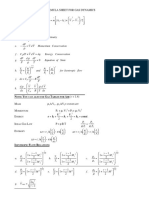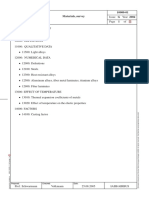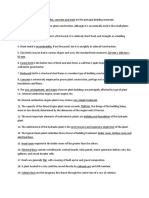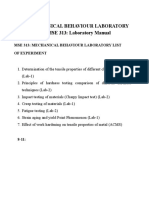Gas Dynamics Equation Sheet
Gas Dynamics Equation Sheet
Uploaded by
Micha VardyCopyright:
Available Formats
Gas Dynamics Equation Sheet
Gas Dynamics Equation Sheet
Uploaded by
Micha VardyOriginal Description:
Original Title
Copyright
Available Formats
Share this document
Did you find this document useful?
Is this content inappropriate?
Copyright:
Available Formats
Gas Dynamics Equation Sheet
Gas Dynamics Equation Sheet
Uploaded by
Micha VardyCopyright:
Available Formats
Adiabatic condition
Gas Dynamics
Units
R
Cp
Cv
[kJ/kgK]
0.2870
[kJ/kgK]
1.005
[kJ/kgK]
0.718
1.400
Temp
from Celsius
9
[F] = [C]
Kelvin
[K] = [C] + 273.15
Rankine
Adiabatic condition
Adiabatic condition
to Celsius
Fahrenheit
+ 32
[C] = ([F] 32)
[R] = ([C] + 273.15)
[C] = ([R] 491.67) 9
lb s
slug ft
1slug 1 F
1 lb F 1 2
ft
m 2
kg m 2
1 J 1 kg 1 2 1 Nm
s
s
2
(Pa)
(bar)
(atm)
(psi)
1 Pa
1 N/m2
1.0197105
1.450377104
1 bar
105
1.0197
14.50377
1 atm
1.01325105
1.0332
14.69595
1 psi
6.8948103
7.03069102
1 lbF /in2
uM
Adiabatic velocity
Stagnation
condition
Stagnation pressure
R0 8.31 J / mol K
emono 1.5RT
enthalpy
Mass
ebi 2.5RT
h e
p
p
a 2 RT
Heating capacity
e
cv
T v
Heating Capacity
ratio
Mach number
R
1
Isentropic condition
pT
/ 1
dh udu dq dws
Euler
udu
P0 , T0 const
p
1
=( )
0
0
0
1 2 1
= (1 +
)
2
0
1 2
=1+
= 0.528
0
0 =
0.528
Isentropic
converging
diverging nozzle
design
A* , Ae
Shock wave
condition
Shock Waves
T0 const
A
1 2 1 2 2 1
M
1
A* M 1
2
Choked speed of
sound
a* RT *
a 1
2 1
Choked speed of
sound, stagnation
relations
* 2
2
a0 2
T*
2
T0 1
T*
a*
0.833,
0.913
T0
a0
P*
*
0.528,
0.634
P0
0
= 0.579
0
Maximum choked
flow rate
0
1 2 1
= (1 +
)
Minimal choked
stagnation
pressure
dp
0
p
P1 Pa
Choked stagnation
isentropic relations
Isentropic
temperature
1
1
Choked cross
section area:
Isentropic pressure
P Pa
Choked stagnation
adiabatic relations
A*
Isentropic density
1 M e
1
Energy
a0
const
Ffric dA
du
dP 0b
X
dx
A
dx
X gx
Isentropic Condition
Isentropic
relations
Friction force
Converging diverging nozzles
* 2
p const
du
dy
Choking condition
cv
u
M
a
cp
Shear stress
Important ideas:
Determine if the procedure is isentropic or adiabatic, if not than
use the ideal gas relations
If the starting velocity values are unknown consider assuming
that the starting condition is stagnation
Choked flow equations
T
P
s c p ln 1 R ln 1
T
2
P2
entropy
vL vL
d uA 0
Momentum
h
cp
T p
C p Cv R
Re
Fundamental Equations
d du dA
0
u A
Continuity
c pT
Speed of sound
Heating Capacity
P0,2
Reynolds number
:
. ,1
0 1 M
1
Stagnation density
P RT ideal
Monoatomic
internal energy
Du-atomic internal
energy
a2
R R0 / m J / mol K
Ideal Gas
T0
1 2
1
M
T
2
2
a02 T0 M
Pe
Avogadros number
Gas Constant
RT0
1 M 2
2
Stagnation Condition
Stagnation speed of
sound, stagnation
temperature
relations
Thermodynamics
N A 6 1023 1/ mol
Pitot Tube
u Ma M RT
[C] = [K] 273.15
9
1 2
= 0 1 = Hg
2
Hg = 13.56 [ 3]
u 2 u max
h0 h
2
2
2
u
T0 T
2c p
M *2
Choked Mach
number
2
1
M2
dA
du
M 2 1
A
u
Variable cross
sectional flow
Flow calculations
Pressure coefficient
p
1
2 0
=
=
(
1)
1 2
12 p1
0
2
How to determine third critical point:
1.
2.
3.
isen P
Ae isen
M e crit ,2
*
A
P0
Shock
P P
M e, x M e,y , y crit ,3
Px Pcrit ,2
Pcrit ,3
Pcrit ,3 Pcrit ,2
P0
Pcrit ,2 P0
Shock Condition:
Pcrit ,1 Pe
isentropic (non-choking)
Pcrit ,3 Pe Pcrit ,1
t s e
Pcrit ,2 Pe Pcrit ,3
e s
s1,2 c p ln
T2
p
R ln 2
T`1
p1
1
1 2 2 1
1
M1
s2 s1
M 2
2
ln
R
M1 1 2
1 2 M 2
1 2 2 1
1
M1
pt 2 M 2
2
pt1 M 1 1 2
1
M
2
fanno
shock
3.
M s , x M s , y L*s,y
4.
LY ,2 L L
*
s, y
M s ,y
*
e
p2 M 1 T2
p1 M 2 T1
Iterative method for finding
AS :
isen
AS calculate AS / A* M S , x
1.
Guess
2.
Determine shock tables M , P
3.
Calculate
4.
Use
5.
determine
/ P01
Pe / P02 M e
MY
AS / Ae
e,y
Pe, y
Pe Pa A
Pe Pa A
p
1
p* M
Psub Pref Psuper
Shockwave between the reference pressure
and the subsonic pressure
2
4.
P
P* P* P0
0.528 0
Pe P0 Pe
Pe
A*
Ae
isentropic
Me
5.
7.
assume that
2.
V* 1
* V M
Pe
P
P02 02
P02
P01
Heat transfer
M2
1
2
2
1/2 1
T
2
T * 1 2
M
1
2
A*
Condition: supersonic inlet flow,
1.
Fanno flow equations
Maximum pipe length without shock wave
*
Fanno condition
LL
Q0
T0 , P, A, , L const
*
Guess 1
L* L
M s , x M1
M1
L*s
LY ,1 L Lx
A3 A4
M4
A5 A5
2.
Lx L*1
qmax c p T0* T01
*
Rayleigh
P, A, , L const
condition
Important ideas:
if a pipe maintains cross sectional area, than the flow rate
can be used to calculate the throat area ratio and can be
used to determine the Mach number
A3 5v5
A5 3v3
Iterative approach to shockwave determination in pipe
m
*v *
q c p T02 T01
m3 m4 m5
v* RT *
Rayleigh flow equations
Max heat transfer
Important ideas:
P* P* T *
P0 T0 R
RT * P0 T0
mRT
D2
M
RT
4
3.
8.
m *v* A*
Pe is given as 1 ATM it is safe to
Me 1
1 2
1
M
t
1
2
*
1
t
M
P02 isentropic
M s,x
P01
isentropic
A
M s , x s* As
A
6.
Ly ,2 Ly1 M x
Important Ideas
1. if M isnt given and
2
1 2
M
1
2
*
*
1 2 1 P A
M e 2 1
Me
Me
2
2 Pe Ae
P* A*
M e 2 1 0.2 M e 2 1.2
Pe Ae
3.
Ly ,2 Ly1 M x
1 2
1
M1
T2
2
1
T1
M 22
1
2
Pe Pa As
Calculation method:
1.
Check isentropic condition:
2.
Ly ,2 Ly1 M x
M1
1
2
As / A*MY
A* / Ae M e,Y Pe,Y / P02 M
7.
1 2
M1
1
2
1 2
1
2
2
1 2
1
M2
2 M 1
2
1 M 2 1 2
P02
A* / Ae A* / As
6.
02
p2 M 1
p1 M 2
M s ,x
P
RT
v M RT
u piston
cs W RT1 1
T0 const
Oblique shock
wave condition
Normal
transformation
Oblique
transformation
M M n sin
Mn
M
sin
2 / tan M12 sin 2 1
tan
M 12 cos 2 2
Beta theta
transformation
RT2
a1 p2 1
1
p1 p2 1
p 1
1
1/2
Oblique shock waves
4.
u2 ' M 2 ' a2
u2 ' cs u p u p
1 p2
1
2 p1
Velocity
transformation
relation
2.
M2
v 6 tan 1
M 2,n
sin
M1, M 2 , M 3
P2 P3
,
P1 P1
1,2 1,3
3.
Calculate
4.
Solve for
3,4 1,3
2,5 1,2
p4 p5
,
p3 p2
p4 p5
5.
/( 1)
1/( 1)
T2 T3
,
T1 T1
Guess
M 1
v M 2 v M1
1 2
1
M1
p2
2
p1 1 1 M 2
2
1 2
2 1 2 M1
1 1 1 M 2
2
Gas Relative
Region in front of the shockwave as region (1), region
behind the shockwave as region (2), the speed of the shock
wave relative to the gas is W.
Shock relative
Given a fixed reference frame to the shock, region 1 is
redefined as x and region 2 is redefined as y.
2.
6 M 2 1 tan 1
1 2
1
M1
T2
2
T1 1 1 M 2
2
P P
M 2,n , 2 , 02
P1 P01
Calculate
Flow angle
transformation
Method for solving non symmetric oblique shock
1.
u' u' 1 '
2 1
M1 1 0
a1 2
1 1 1
2
1
v
tan
M 1 tan
1
1
M1 oblique
M1,n M1 sin
M1,n
' 2
1
Prandtl Meyer angle
1 p2
1 p1
p2 1
1
p1 1
Shock
3.
Prandtl Meyer flow
Method for solving oblique shock waves
1.
u2' u1'
2 M1 1
a1
1 M 1'
' 2
1 p2
1
2 1 p1
1
1 p2
1 p1
T2 p2
T1 p1
T2 a2
u y W u1 u2
My
W u1 u2
a2
p1 px
p2 p y
; T1 Tx
; T2 Ty ,
1 x ; 2 y ; a1 ax ; a2 a y ,
Mx
ux W
,
ax a1
My
uy
ay
W u1 u2
a2
a2
2( 1)
1
2
1
M x 2 ( 1)
a1
( 1) 2
Mx
2
1
1
2
1
1
1
1 M x2
p2
2
M 2 1
1
p1
1 x
Moving shockwave coordinate transformation:
p4 p5
p4 p5
Moving Shock Waves
1.
Define coordinate system
2.
u1 '
M1 '
RT1
3.
shock
p T
M 1 ' M 2 ', 2 , 2
p1 T1
u1 ' cs u1
u 2 ' cs
max
1
1
2 1
max max ( M 1 )
You might also like
- Formula Sheet For Gas DynamicsDocument3 pagesFormula Sheet For Gas DynamicsAdnan PirbhaiNo ratings yet
- HSB English v1 0 0 - Chapter - 10000 00 PDFDocument320 pagesHSB English v1 0 0 - Chapter - 10000 00 PDFAdina CiopataNo ratings yet
- ME 510 - Gas Dynamics Final Exam Spring 2009 NameDocument9 pagesME 510 - Gas Dynamics Final Exam Spring 2009 NameGCVishnuKumarNo ratings yet
- Thermodynamics (Prausnitz) Manual SolutionDocument195 pagesThermodynamics (Prausnitz) Manual SolutionColin Zhang78% (9)
- Crank Nicholson MethodDocument49 pagesCrank Nicholson MethodAbdul RahimNo ratings yet
- Detailing To Eurocode 2Document12 pagesDetailing To Eurocode 2Bhandari_007100% (1)
- Mach NumberDocument54 pagesMach NumberMohammed Al-samarraeNo ratings yet
- CH 13 EquationsDocument3 pagesCH 13 EquationsVenkatNo ratings yet
- High Speed AeroydnamicsDocument6 pagesHigh Speed AeroydnamicsmohdrashdansaadNo ratings yet
- GasDynamic SubroutinesDocument4 pagesGasDynamic SubroutinesYasser BahaaNo ratings yet
- Khosravy - Isentropic FlowDocument25 pagesKhosravy - Isentropic FlowFejs Za ScribdNo ratings yet
- Solutions To Unit 1 Homework No. 1: RT R K RT ZDocument7 pagesSolutions To Unit 1 Homework No. 1: RT R K RT ZGurunath EpiliNo ratings yet
- Chapter 3Document15 pagesChapter 3Bheemesh GudelliNo ratings yet
- hw1 SolutionsDocument3 pageshw1 SolutionsFatih İnalNo ratings yet
- CH 13 EquationsDocument2 pagesCH 13 EquationsVenkatNo ratings yet
- Molecular Thermodynamics Prausnitz Manual SolutionDocument195 pagesMolecular Thermodynamics Prausnitz Manual Solutionsolee426No ratings yet
- Supersonic Flow Over A Wedge (Oblique Shock Problem)Document29 pagesSupersonic Flow Over A Wedge (Oblique Shock Problem)sameer100% (2)
- Aerodynamics ExercicesDocument5 pagesAerodynamics ExercicesMarcRosetNo ratings yet
- Intro Comp FlowDocument14 pagesIntro Comp FlowJoão HenriquesNo ratings yet
- Motion of The Ablation Cloud in Torus Plasmas: R.Ishizaki, N.Nakajima and M.Okamoto National Institute For Fusion ScienceDocument16 pagesMotion of The Ablation Cloud in Torus Plasmas: R.Ishizaki, N.Nakajima and M.Okamoto National Institute For Fusion Scienceดร.พลกฤษณ์ คล้ายวิตภัทรNo ratings yet
- Cheatsheet Kimia FisikaDocument5 pagesCheatsheet Kimia FisikaAlwendo GunawanNo ratings yet
- ICAR UG Physics 22 September 2020 Shift 1 Solutions and Solved PaperDocument107 pagesICAR UG Physics 22 September 2020 Shift 1 Solutions and Solved PaperLibgenNo ratings yet
- MM FormulaeDocument2 pagesMM FormulaeReddyvari VenugopalNo ratings yet
- Communication SystemsDocument35 pagesCommunication SystemsSudhamsh Maddala100% (1)
- 2-Presentation 2 MPE 311Document34 pages2-Presentation 2 MPE 311ahmeddawod825No ratings yet
- Optimizing Phases of CPMG Pulse Sequence and Applying Exact Solution To Measure Relaxation TimeDocument29 pagesOptimizing Phases of CPMG Pulse Sequence and Applying Exact Solution To Measure Relaxation TimehellorunNo ratings yet
- One-Dimensional Flow: Modern Compressible Flow, Chap 3Document35 pagesOne-Dimensional Flow: Modern Compressible Flow, Chap 3Arul SankaranNo ratings yet
- Compressibility Factor Z CalcDocument3 pagesCompressibility Factor Z CalcknsaravanaNo ratings yet
- Compressibility Factor Z CalcDocument3 pagesCompressibility Factor Z CalcSrihari KodimelaNo ratings yet
- Aerodynamics-Problems (Has 1.9)Document13 pagesAerodynamics-Problems (Has 1.9)itsnewby100% (1)
- Unit II and IIIDocument42 pagesUnit II and IIIprakashNo ratings yet
- Response Spectrum Analysis PDFDocument30 pagesResponse Spectrum Analysis PDFSujay Santra100% (1)
- Lecture 8 of Tropical MeteorologyDocument22 pagesLecture 8 of Tropical MeteorologyMelvin BadonNo ratings yet
- Two Dimensional Oblique Shocks Expansion FlowsDocument18 pagesTwo Dimensional Oblique Shocks Expansion FlowsSakib RajiunNo ratings yet
- Fanno FlowDocument30 pagesFanno FlowAitizaz KhanNo ratings yet
- P6-Polarization and Crystal OpticsDocument55 pagesP6-Polarization and Crystal OpticsUni NgoNo ratings yet
- Study MaterialDocument42 pagesStudy MaterialWhite DevilNo ratings yet
- Transient Conduction: Finite-Difference Equations and SolutionsDocument17 pagesTransient Conduction: Finite-Difference Equations and Solutionst8e7w2koNo ratings yet
- Departure FunctionDocument6 pagesDeparture FunctionzidinhoNo ratings yet
- Generalized CompressibilityDocument17 pagesGeneralized CompressibilityappealmNo ratings yet
- Eiiunivteity: Independentv Ontrolof TH Ive-L Bythe Expandedtwo-Arm OdulatbnmDocument7 pagesEiiunivteity: Independentv Ontrolof TH Ive-L Bythe Expandedtwo-Arm OdulatbnmkesraouihichemNo ratings yet
- Suffa Gas Dynamics CH 1 and 2 PDFDocument19 pagesSuffa Gas Dynamics CH 1 and 2 PDFSyed Qassam Mustafa SadiqullahNo ratings yet
- M-C. Angoninand Ph. Tourrenc - Cold Atom Interferometer in A Satellite: Orders of Magnitude of The Tidal EffectsDocument19 pagesM-C. Angoninand Ph. Tourrenc - Cold Atom Interferometer in A Satellite: Orders of Magnitude of The Tidal EffectsPortsnuyhNo ratings yet
- Reservoir Seismic 6Document57 pagesReservoir Seismic 6Manish ChaturvediNo ratings yet
- 4.2 - Kinetic Theory of GasDocument28 pages4.2 - Kinetic Theory of GasHONG XIANo ratings yet
- Kinetics Analysis - Differential, Integral, Half Life, Arrhenius ExpressionDocument3 pagesKinetics Analysis - Differential, Integral, Half Life, Arrhenius ExpressionParth AnadkatNo ratings yet
- Advanced Microwave EngineeringDocument12 pagesAdvanced Microwave Engineeringkwizera evaNo ratings yet
- Sweet Baby Dresses in Crochet: 4 Dresses in Sizes Newborn to 24 Months, with Matching AccessoriesFrom EverandSweet Baby Dresses in Crochet: 4 Dresses in Sizes Newborn to 24 Months, with Matching AccessoriesRating: 4 out of 5 stars4/5 (2)
- Analog Dialogue, Volume 48, Number 1: Analog Dialogue, #13From EverandAnalog Dialogue, Volume 48, Number 1: Analog Dialogue, #13Rating: 4 out of 5 stars4/5 (1)
- Exercises in Electronics: Operational Amplifier CircuitsFrom EverandExercises in Electronics: Operational Amplifier CircuitsRating: 3 out of 5 stars3/5 (1)
- A Modern Course in Statistical PhysicsFrom EverandA Modern Course in Statistical PhysicsRating: 3.5 out of 5 stars3.5/5 (2)
- Feynman Lectures Simplified 2C: Electromagnetism: in Relativity & in Dense MatterFrom EverandFeynman Lectures Simplified 2C: Electromagnetism: in Relativity & in Dense MatterNo ratings yet
- Python Regular Expressions Cheat Sheet PDFDocument1 pagePython Regular Expressions Cheat Sheet PDFsharathdhamodaranNo ratings yet
- Finite Element Analysis Set Up and Results: Material Properties: Taken FromDocument6 pagesFinite Element Analysis Set Up and Results: Material Properties: Taken FromMicha VardyNo ratings yet
- Project ProposalDocument2 pagesProject ProposalMicha Vardy100% (1)
- GT&DDocument17 pagesGT&DMicha VardyNo ratings yet
- Oral PresentationDocument29 pagesOral PresentationPraveen FernandoNo ratings yet
- Me 321: Fluid Mechanics-I: Dr. A.B.M. Toufique HasanDocument16 pagesMe 321: Fluid Mechanics-I: Dr. A.B.M. Toufique HasanankitaNo ratings yet
- Pmt3i001 Principles of Extractive Metallurgy 2017Document2 pagesPmt3i001 Principles of Extractive Metallurgy 2017Rohan Singh100% (1)
- Welded Precision Steel Tubes Technical Information RoundDocument1 pageWelded Precision Steel Tubes Technical Information RoundsalimmalmaliNo ratings yet
- Electrical and Communication - Design Review ChecklistDocument7 pagesElectrical and Communication - Design Review ChecklistAmr AtefNo ratings yet
- Grundfos Ups 2580 180Document2 pagesGrundfos Ups 2580 180SAURABH PRADHANNo ratings yet
- Elements Chapter 4 Power Plant Building Group 3Document3 pagesElements Chapter 4 Power Plant Building Group 3Jose Lapera Jr.No ratings yet
- Bsi STD DWG El 001 Electrical Standard Installation 1of6Document1 pageBsi STD DWG El 001 Electrical Standard Installation 1of6dharuNo ratings yet
- 16 - Bruce Ireland - Joint DetailsDocument32 pages16 - Bruce Ireland - Joint DetailsTian NgNo ratings yet
- Stress-Phase-Transformation Interactions - Basic PDocument11 pagesStress-Phase-Transformation Interactions - Basic PRoberto AbreuNo ratings yet
- Thermal PasteDocument3 pagesThermal PastejuarezcruzNo ratings yet
- Supply of Materials For MaintenanceDocument71 pagesSupply of Materials For Maintenancejordan waldmanNo ratings yet
- Fallsem2020-21 Che2002 Eth VL2020210101718 Cat-1 QP Key Cat I PedeDocument2 pagesFallsem2020-21 Che2002 Eth VL2020210101718 Cat-1 QP Key Cat I PedesubramanianNo ratings yet
- Mechanical Behaviour Laboratory MSE 313: Laboratory ManualDocument41 pagesMechanical Behaviour Laboratory MSE 313: Laboratory ManualVenkteshwarlu KNo ratings yet
- Testing of Fresh and Hardened Concrete - Quality of ConcreteDocument26 pagesTesting of Fresh and Hardened Concrete - Quality of ConcreteJeya LakhsmiNo ratings yet
- Architecture Follows Sun - Arvind Krishan PaperDocument6 pagesArchitecture Follows Sun - Arvind Krishan PaperVaibhav JainNo ratings yet
- User Manual - Forma - 3029, 3039 - Countertop Incubator 10 Cu - Ft. - 7013029Document52 pagesUser Manual - Forma - 3029, 3039 - Countertop Incubator 10 Cu - Ft. - 7013029cruzrenato100% (2)
- Loctite Stycast 2762: Technical Data SheetDocument3 pagesLoctite Stycast 2762: Technical Data SheetankitaNo ratings yet
- Ice PlantDocument25 pagesIce PlantAbenliciousNo ratings yet
- Extruder Tutorial PDFDocument314 pagesExtruder Tutorial PDFAntonius PrakosaNo ratings yet
- FLD-Office Almirah Price Final With Additional Price PDFDocument2 pagesFLD-Office Almirah Price Final With Additional Price PDFanikNo ratings yet
- Saudi Aramco Inspection Checklist: SAIC-P-3333 Elect-Ductbank / Conduit Excavation, Trenching and BackfillingDocument6 pagesSaudi Aramco Inspection Checklist: SAIC-P-3333 Elect-Ductbank / Conduit Excavation, Trenching and Backfillingmkalidas2006No ratings yet
- Energy and Buildings: Y. Florentin, D. Pearlmutter, B. Givoni, E. GalDocument13 pagesEnergy and Buildings: Y. Florentin, D. Pearlmutter, B. Givoni, E. GalArlen GutierrezNo ratings yet
- Sight Glass General Characteristics: Flow Indicator 7.1. Visoflow WO1 - GM/GKDocument1 pageSight Glass General Characteristics: Flow Indicator 7.1. Visoflow WO1 - GM/GKAnonymous 9WNqHZNo ratings yet
- Bimal ProfileDocument19 pagesBimal ProfileAjit ChauhanNo ratings yet
- Specification Sheet: West-Com Part WYP Paige Part 32WYPWESTDocument2 pagesSpecification Sheet: West-Com Part WYP Paige Part 32WYPWESTAnonymous XYAPaxjbYNo ratings yet
- Maguera SPX FlexDocument2 pagesMaguera SPX FlexJulio PrietoNo ratings yet
- Manual Smart Panels G2 RBF SBF PNL910-02Document8 pagesManual Smart Panels G2 RBF SBF PNL910-02Francisco LopezNo ratings yet





























































































